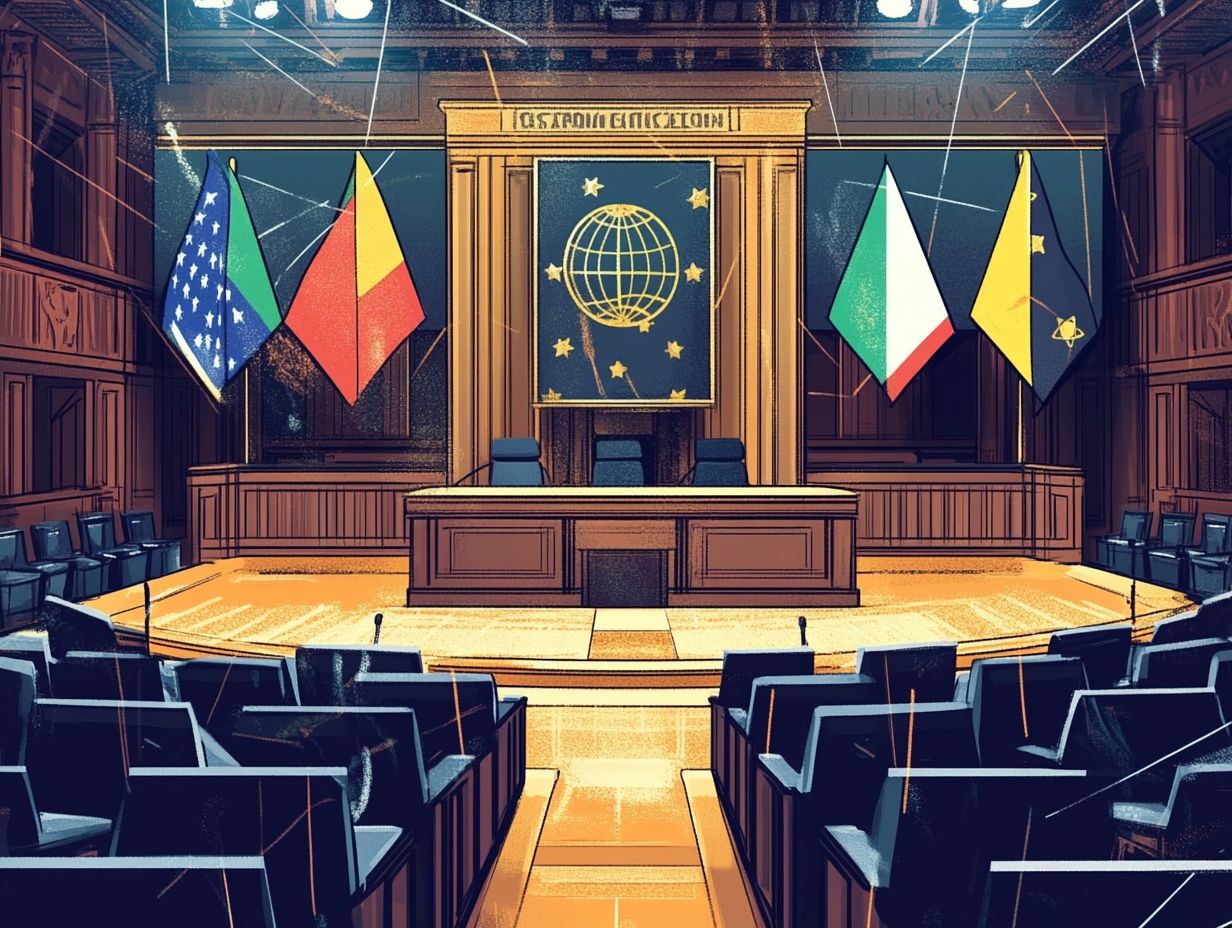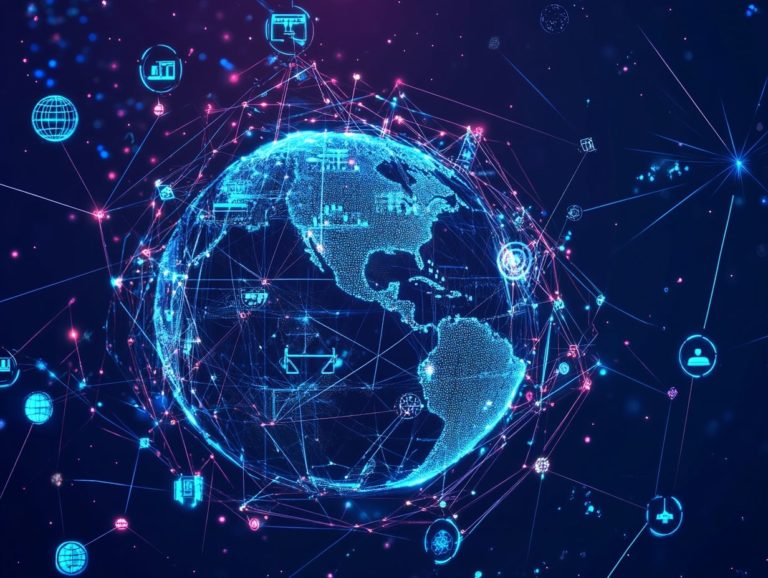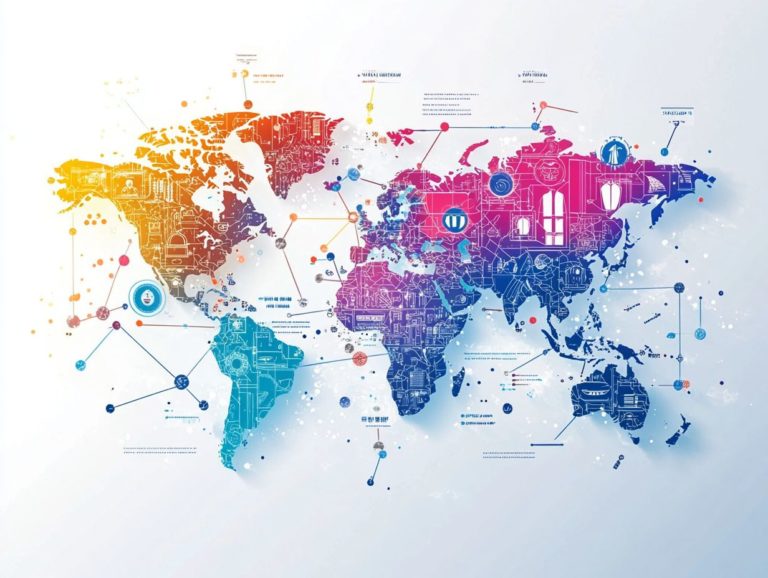5 Key Differences Between Domestic and International IP Law
Understanding intellectual property (IP) law is essential for your business. The differences between domestic and international IP laws can be challenging to navigate.
This article delves into five key differences, covering everything from jurisdiction and protection periods to registration processes and enforcement of rights. It also addresses how these disparities impact your business, highlighting the advantages and disadvantages of each system, as well as the common challenges you may encounter.
By the end of this article, you’ll understand how to confidently protect your intellectual property globally!
Contents
- Key Takeaways:
- 1. Jurisdiction
- 2. Protection Period
- 3. Registration Process
- 4. Enforcement of Rights
- 5. Recognition of Foreign Rights
- What Are the Main Differences Between Domestic and International IP Law?
- How Do These Differences Affect Businesses?
- What Are the Advantages and Disadvantages of Each System?
- How Can a Business Protect Their Intellectual Property Internationally?
- What Are the Common Challenges Faced by Businesses in Terms of International IP Law?
- What Are the Potential Consequences of Not Understanding the Differences Between Domestic and International IP Law?
- Frequently Asked Questions
- What is the difference between domestic and international IP law?
- What are the main differences between domestic and international IP law?
- What is the scope of IP law?
- How does enforcement differ between domestic and international IP law?
- What are the key factors that affect the protection of intellectual property rights under domestic and international law?
Key Takeaways:

Domestic IP law applies within a specific country, while international IP law applies across multiple countries. The protection period for domestic IP is typically shorter than international IP, which can vary between countries. The registration process for domestic IP is usually simpler and less expensive compared to international IP.
1. Jurisdiction
Understanding the differences in laws of intellectual property (IP) is essential for you as a U.S. company aiming to skillfully navigate the intricacies of both U.S. and international intellectual property law. Familiarizing yourself with notable international IP cases can help illustrate how these laws can differ dramatically across various jurisdictions, influencing your strategies for patent, copyright, and trademark protection in diverse foreign markets.
You must recognize that the U.S. Patent and Trademark Office offers crucial guidelines for securing patents and trademarks domestically. The European Patent Office adds complexity with its unique regulations. As your business expands globally, the interactions between these jurisdictions demand meticulous attention.
A single misstep can result in costly disputes and inadequate protection for your valuable assets. Thus, consulting with experts like Klemchuk PLLC becomes critical. They offer specialized knowledge that ensures you make informed decisions tailored to your specific IP needs.
2. Protection Period
The protection period for U.S. patents, copyrights, and trademarks varies significantly, influencing how you strategize your intellectual property rights in both domestic and international markets.
For example, utility patents typically last for 20 years from the date of application, while design patents enjoy a shorter protection term of 15 years after being granted. In contrast, copyright protection lasts the lifetime of the author plus 70 years, offering a more extended safeguard for creative works. Trademarks, meanwhile, can be renewed indefinitely as long as you continue to use them in commerce.
When you consider international norms, such as the European Union’s 10-year trademark renewals, it’s essential to grasp these differences. These durations directly impact your market entry strategies; longer protection can enable you to make more impactful and confident investments in foreign markets.
3. Registration Process
The registration process for patents and trademarks in the U.S. requires navigating the complexities of the U.S. Patent and Trademark Office, which operates under the guidelines established by the America Invents Act. This includes the first-to-file system and the absolute disclosure rule.
You must be thoroughly prepared when submitting your applications. Start by determining whether your invention or trademark qualifies for protection, which involves conducting a comprehensive search of existing patents and trademarks.
Once you’ve established eligibility, gather essential documentation, including detailed descriptions, drawings, and claims. Be aware that fees vary based on the type of application and your entity status, so financial planning is key.
It’s crucial to understand the implications of the America Invents Act, as it underscores the importance of timely filing. This ensures that your intellectual property is protected against competing claims.
4. Enforcement of Rights

Enforcing intellectual property rights is essential for U.S. companies. It involves strategies like fighting against counterfeit products in local and international markets.
Companies often use a mix of court actions and other methods to protect their innovations and brands from illegal use. However, enforcing these rights can be challenging, especially in foreign markets where laws differ greatly.
You may encounter issues like different laws and weak enforcement, making it harder to act. Local authorities may also be hesitant to help, adding to the complications.
Navigating international treaties is crucial. These agreements help standardize IP protection and encourage cooperation against infringement worldwide.
5. Recognition of Foreign Rights
Recognizing foreign rights is vital for international trade. Agreements like the Berne Convention and the Universal Copyright Convention, supported by organizations like the World Intellectual Property Organization, provide this framework.
These agreements allow you to protect your intellectual property (IP) rights abroad. For instance, under the Berne Convention, your U.S. copyrights are generally respected in member countries without needing formal registration.
The TRIPS Agreement also sets global standards for patent protection. This allows you to seek legal help in foreign countries, making it easier to safeguard your business.
What Are the Main Differences Between Domestic and International IP Law?
The differences between domestic and international IP law significantly impact how you protect your intellectual property, and understanding the key differences between IP litigation and other litigation is crucial. Various regulations, like those from TRIPS, exist in different countries.
Domestic laws often offer a clearer framework. In contrast, international laws can create complexities, such as varying registration processes.
Enforcement mechanisms also differ greatly. Some countries may lack strong measures to prevent infringement, leaving you open to risks.
Your rights often depend on bilateral agreements. Navigating these legalities is essential for developing strategies tailored to the unique challenges of foreign markets.
How Do These Differences Affect Businesses?
The differences in IP law can greatly shape your business strategies, particularly when entering international markets where the recognition of rights varies. Understanding the key differences between patents and trademarks is crucial in navigating these complexities.
For example, understanding IP laws is crucial when developing a product for global distribution. It can influence your choices about materials and design, helping you avoid infringement issues.
In marketing, diverse standards of fair use can dictate how you design promotional campaigns. This affects everything from visuals to music selection.
Implementing strong risk management strategies, such as IP audits and international patents, is vital. These actions help shield your innovations from local competitors and counterfeit threats.
This proactive approach is key for U.S. firms aiming to thrive in various markets.
What Are the Advantages and Disadvantages of Each System?

Understanding the advantages and disadvantages of both U.S. Intellectual Property Law and International Intellectual Property Law is essential for you as a business leader. This knowledge helps maximize protection while minimizing risks associated with infringement and enforcement.
In today’s globalized economy, you often find yourself navigating complex legal landscapes. These can be quite challenging.
The ease of registration varies significantly between these systems. While U.S. law provides a straightforward process, international regulations can be cumbersome and inconsistent.
These inconsistencies lead to frustrating delays in obtaining protection. Enforcement mechanisms aren t universally robust either, which means you might encounter challenges when asserting your rights abroad.
This scenario can lead to potential costs, both financial and resource-related. Such issues may hinder your ability to compete effectively in foreign markets.
Ultimately, grasping these nuances enables you to make informed decisions that align seamlessly with your strategic goals.
How Can a Business Protect Their Intellectual Property Internationally?
To protect your intellectual property on an international scale, you must navigate complex treaties. Treaties are agreements between countries that establish legal standards and protections.
Implement strategic measures tailored to various foreign markets; this is essential for U.S. companies aiming to expand globally. This process requires not only registering your IP with relevant foreign offices but also leveraging international agreements that offer extra layers of protection.
Understanding the nuances of local regulations is vital. You can devise a robust strategy that minimizes the risks associated with infringement.
Engaging local legal counsel is crucial. These professionals provide invaluable insights into jurisdiction-specific laws and practices.
They help you tailor your approach effectively, addressing potential challenges while streamlining registration processes. This ensures your assets remain secure in an increasingly competitive global landscape.
What Are the Common Challenges Faced by Businesses in Terms of International IP Law?
Businesses, especially those in the U.S., encounter a myriad of challenges when dealing with international IP law. You may face issues related to foreign manufacturers, disparate enforcement practices, and varying levels of recognition for IP rights.
Language barriers can complicate these hurdles, leading to misunderstandings in contractual agreements. You might also confront unique legal standards that differ significantly from what you’re accustomed to in the United States.
In certain regions, intellectual property laws may not provide the same level of protection. This can expose you to infringement risks without adequate recourse.
Consider the example of a U.S. tech firm that successfully expanded into China by forming partnerships with local entities. This strategic move allowed them to navigate local IP laws effectively while establishing a robust enforcement strategy.
Such case studies underscore the critical importance of adaptability and local expertise in overcoming these complex obstacles.
What Are the Potential Consequences of Not Understanding the Differences Between Domestic and International IP Law?
Failing to grasp the nuances between domestic and international IP law can lead to serious repercussions for your U.S. company. This includes potential legal disputes, loss of intellectual property rights, and substantial financial setbacks in foreign markets, making it crucial to focus on navigating IP law across borders.
These consequences can take many forms. Consider Microsoft, for example, which encountered significant legal hurdles in Europe due to its software patenting practices.
Similarly, top technology firms have faced challenges in countries with strict regulations. These situations can lead to expensive litigation and tarnished brand reputations.
A lack of awareness regarding these legal distinctions can put your competitive edge at risk. Therefore, investing in comprehensive education on international IP compliance is crucial for your success!
By staying informed, you can navigate potential risks and protect your innovations. This creates a more secure environment for your global operations.
Frequently Asked Questions

What is the difference between domestic and international IP law?
Domestic IP law governs intellectual property rights within a specific country, while international IP law addresses how these rights differ across various countries.
What are the main differences between domestic and international IP law?
Domestic and international IP laws differ in scope, enforcement, and protection of intellectual property rights. For a deeper understanding, you can explore the 5 major developments in international IP law as they also highlight different legal frameworks and legal authorities.
What is the scope of IP law?
Domestic IP law focuses on rights within one country, while international IP law addresses these rights between countries.
How does enforcement differ between domestic and international IP law?
Enforcement is crucial for protecting your ideas. Domestic laws are enforced by local governments, while international agreements help enforce rights across borders.
What are the key factors that affect the protection of intellectual property rights under domestic and international law?
The legal frameworks, cultural differences, and economic conditions of different countries can greatly impact the protection and recognition of intellectual property rights.






